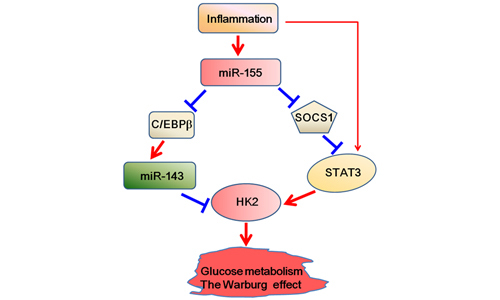MicroRNA-155 Links Inflammation to the Warburg Effect
Source:
Time: 2012-02-24
Cancer cells preferentially metabolize glucose through aerobic glycolysis. This phenomenon, known as the Warburg effect, is an anomalous characteristic of glucose metabolism in cancer cells. Chronic inflammation is a key promoting factor of tumorigenesis. It remains, however, largely unexplored whether and how pro-tumorigenic inflammation regulates cancer cellular energy metabolism. Recently, a team of researchers, led by Prof. LIU Mofang at the Shanghai Institute of Biochemistry and Cell Biology (SIBCB), Shanghai Institutes for Biological Sciences, Chinese Academy of Sciences, provided direct evidence that inflammatory signals regulate the Warburg effect in cancer cells.
JIANG Shuai, ZHANG Lingfei and their colleagues, under the supervision of Dr. LIU Mofang, study the roles and mechanisms of pro-tumorigenic inflammation in glucose metabolism in cancer cells. They found that pro-inflammatory cytokines promote glycolysis in breast cancer cells, and that the inflammation-induced miR-155 functions as an important mediator in this process. Mechanistically, miR-155 exerts its role in glycolysis mainly by up-regulation of hexokinase2 (hk2), a key glycolytic enzyme and pivotal player in the Warburg effect, through two distinct mechanisms. First, miR-155 promotes hk2 transcription by activation of STAT3, a transcriptional activator for hk2. Second, via targeting C/EBPβ (a transcriptional activator for mir-143), miR-155 represses mir-143, a negative regulator of hk2, thus resulting in up-regulation of hk2 expression at the post-transcriptional level. The miR-155-mediated hk2 up-regulation also appears to operate in other types of cancer cells examined, suggesting that this dual-miRNA-mediated regulation of hk2 may represent a common mechanism linking inflammation to the altered metabolism in cancer cells.
This work entitled “A novel miR-155/miR-143 cascade controls glycolysis by regulating hexokinase 2 in breast cancer cells” was published online in The EMBO Journal onFebruary 21st, 2012, before its appearance in print.
This study was supported by grants from the Chinese Academy of Sciences, the Ministry of Science and Technology, National Natural Science Foundation of China, and the Science and Technology Commission of Shanghai Municipality.
AUTHOR CONTACT:
LIU Mofang
Shanghai Institute of Biochemistry and Cell Biology, Shanghai Institutes for Biological Sciences, Chinese Academy of Sciences, Shanghai, China
Model of the dual-switch mechanism through which miR-155 conveys the inflammatory signals to the Warburg effect. (Image provided by Dr. LIU Mofang)

 Appendix:
Appendix: